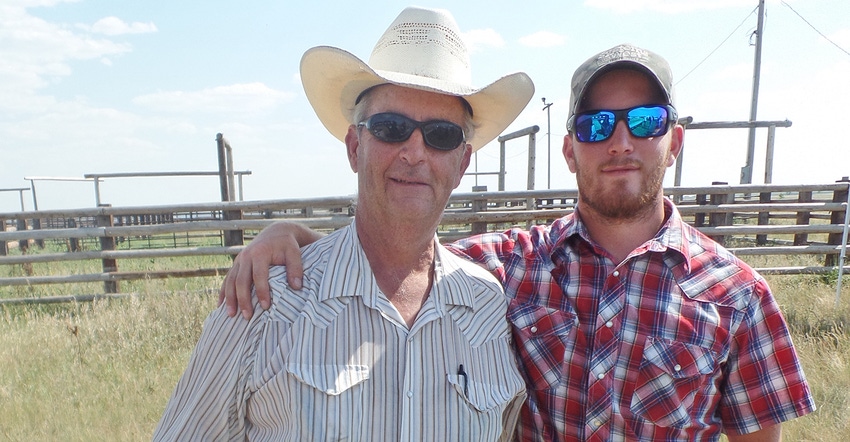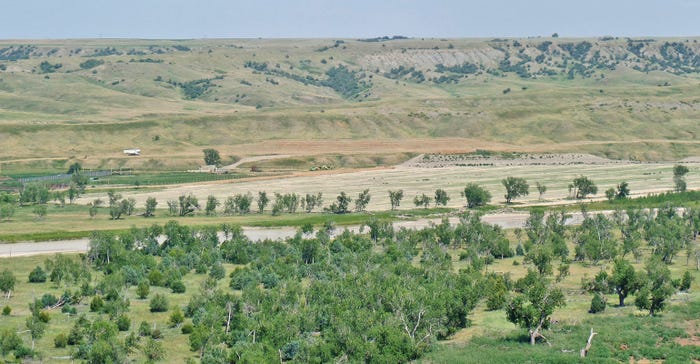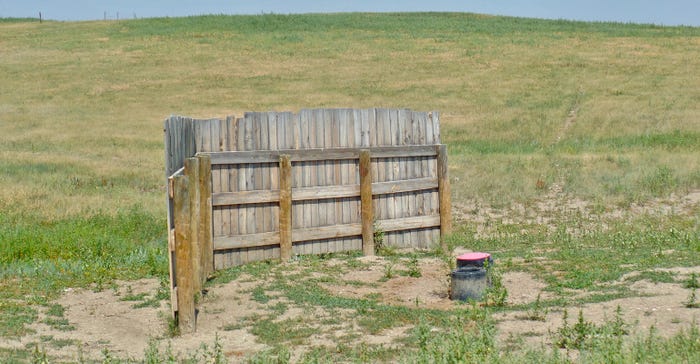September 27, 2018

By Kindra Gordon
"We try not to let any water get away," Todd Trask said many times as he and son, Tyler, 24, hosted a tour of the Trask Angus Ranch in August. The Trask family received the 2018 Excellence in Range Management Award from the South Dakota Section of the Society for Range Management.
Located near Wasta, S.D., the ranch receives about 16 inches of precipitation in a good year, with temperatures ranging from over 100 degrees F in the summer to well below zero in the winter. Due to the challenging environment, the Trasks use many conservation practices — and are continuously adapting — to keep their ranch viable.
Todd was born and raised on the ranch, which is situated along the rugged rangeland bordering the Cheyenne River, and today is home to 400 registered Angus cow-calf pairs. Todd and his wife, Samara, have three daughters and son, Tyler, who joined the operation full-time after graduating from high school.
"We try to run year-round on grass, with some supplemental protein [cake] fed in the winter. On a normal year, we try to feed minimal hay, so grass is a big deal for us," Todd said.
 GRAZING AWARD: Todd Trask (left) accepts the 2018 Excellence in Range Management Award during a tour of his family’s ranch.
GRAZING AWARD: Todd Trask (left) accepts the 2018 Excellence in Range Management Award during a tour of his family’s ranch.

During the recent tour, Todd explained the four main management strategies they are following on their ranch:
1. Maintain a herd size suitable for your resources. The Trasks run a herd of 400 Angus cows, with heifers calving in early February and the mature cow herd starting to calve by March 10. They utilize artificial insemination and sell registered bulls each March.
Of their herd size, Trask said, "400 head — that's what we can run year in and out. We could've run more this year with all the rain, but we didn't have the grass the last two years. So, we stock at a number we can maintain, and it creates less stress."
The cows are kept on pasture from November through May, with supplemental hay and protein fed as needed. Through the summer, the herd is rotated through three section-size pastures.
"I like to give the grass a chance to get up and get ahead," Todd said. "I don't overstock it." He notes that by maintaining forage cover, they capture more precipitation that soaks in rather than runs-off.
2. Invest in water. In the '80s and '90s the Trasks dug two wells and installed several miles of pipeline and tanks. They are in the process of partnering with a neighbor to add a third deep well to further develop a pipeline watering system.
"I can't say enough about good water," Todd said. "Cattle will stand in the river, but they drink from the tanks. ... We see wildlife using the tanks all the time, too."
 RANGELAND: Breaks along the Cheyenne River are part of the Trask ranch.
RANGELAND: Breaks along the Cheyenne River are part of the Trask ranch.

Fresh water adds about 40 pounds per calf weaned annually, Todd said. He tells of having his mature cows on the flat pastures with fresh water and his young cows on the river pasture, and the young cows had 15% to 18% open and calves were 40 pounds lighter than the mature cows' calves. When he switched and put the young cows on the flats with fresh water, the results flipped, and the young cows had calves 40 pounds heavier.
"I attribute it to the water. It made a huge believer of me. They love that fresh water. If you have a chance to do it [add pipelines], do. Building a dam is a waste of resources I think," Todd said.
The Trasks have installed several Thermosink water tanks, which are designed to work without electricity and do not require concrete. (Learn more at thermosink.com.) To accommodate winter grazing, they put wood windbreaks to the north of the water tanks, which typically prevents the tanks from freezing.
Todd converted wells to constant pressure pumps, a practice covered by the Conservation Stewardship Program.
"We reduced our electric bill $150 per month, got rid of pressure tanks and have had no maintenance," he reports. Todd liked the constant pressure system so much he even put his house on it.
 FREEZE PREVENTER: Wood windbreaks on the northside of Thermosink water tanks helps prevent the water from freezing in the winter.
FREEZE PREVENTER: Wood windbreaks on the northside of Thermosink water tanks helps prevent the water from freezing in the winter.

3. Use management, not necessarily more inputs, to address resource issues. On rangeland areas where the Trasks are trying to improve pasture conditions, they have learned to use the cowherd as a management tool. For instance, in a pasture where cheatgrass was an issue, Todd didn't want to spray a herbicide. He instead is grazing those areas heavily in fall and early spring. As a result, more western wheatgrass is establishing in those areas.
Additionally, when feeding hay, they place the bales on shallow upland sites in order to add more litter and manure to those area, which helps improve soil health and promote vegetative growth.
4. Be willing to adapt. Through the decades, the Trasks have had a mindset to always adjust and adapt. Most recently, at their second farmstead, across the Cheyenne River from their homeplace they've initiated a project to add more feedbase for their cattle.
Tyler lives on this farmstead and winters the young cows there. They also calve the young herd there, and they wean and artificially inseminate the young cows at the facility. They leveled land around this second site and have created dams and ditching to create an irrigation system. Millet, radishes and peas were planted in August and the crop will be used for hay or grazing this fall and winter. "We may be able to run replacement heifers on it all winter," Todd said.
More of Trask's tactics
Todd and Tyler Trask calve their mature cowherd on the flats next to the river, with the steep river bank walls giving protection from the wind. "This gives protection as good as any barn," Todd said.
Because of the rugged country, the Trasks do a lot of their ranch work on horseback. A couple years ago, though, they invested in a utility vehicle, and Todd has found it's a fairly quick means to get to the cowherd as well.
Replacement heifers are synchronized and then artificially inseminated over a 21-day time span, with pregnancy testing done at 30 days. Open females are sold at that time, typically in late July.
Two- and three-year-old cows are kept separate from the mature cowherd. When the three-year-olds are eventually added to the cowherd, older cows are culled and marketed annually to maintain herd size.
As the Trasks look to establish more forage to extend their feeding options, Todd said they want crops that can be hayed and then grazed. He said he may not plant more alfalfa because it can't be grazed as easily in the winter. He instead plans to look to other legumes and annual forage mixes.
 BRAND SIGN: A sign with the Trask Angus brand marks the road to the ranch headquarters.
BRAND SIGN: A sign with the Trask Angus brand marks the road to the ranch headquarters.

Thirty years ago, Todd furrowed one area of his native range pasture that was overgrazed and sod bound. "What came back was western wheatgrass and it looked like a field. Those furrows collect water; it has drought-proofed the ranch," Todd said. The furrowed area is rough. You can't drive across it, but Trask likes how much it reinvigorated the grass. He is considering furrowing another area of a pasture.
Todd was frustrated with tumbleweeds and other dried plant material accumulating along the bottom wire of his four-wire fences. Extra snow would also pile up there and pull the wire down. He is now taking the bottom wire off in some areas, allowing plant material to blow free and making it easier for birds and wildlife to move around as well.
Gordon writes from Whitewood, S.D.
You May Also Like




